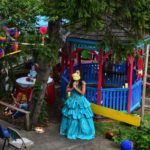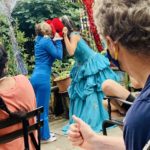I don’t usually wear a helmet to the theatre. I usually don’t pack rolls of disinfectant wipes either, but theatre in the time of COVID is a particular experience. Last Friday I mounted a Citi Bike and ventured three and a half miles from my neighborhood of Greenpoint to Bushwick to break my 162-day lull in theatregoing. Quince, a socially distant outdoor production at the People’s Garden, was my joyful reintroduction.
Camilo Quiroz-Vazquez’s Quince, performed for free to limited audiences over four performances on Aug. 21 and 22, was an interactive quinceañera co-produced by the TEAM and directed by Ellpetha Tsivicos. The play followed Cynthia, a 14-year-old confronting her queer identity, her faith, and her relationship with her parents on the eve of her quinceañera—the Mexican tradition that celebrates a girl’s transition into womanhood on her 15th birthday with ball gowns, balloons, and bouquets.
The night was all about Cynthia, but I was experiencing my own rite of passage. I moved to New York City 10 years ago to the day. I used to imagine celebrating a decade in the city with a party of my own, maybe even with balloons. I will admit that over the past few months, as I’ve holed up in my apartment social distancing, I’ve wondered if this decade mark might close my chapter in the city. These 10 years have been filled with lots of theatre and events and parties, and the last few months have been filled with a lot of fear and loneliness and confusion. What is New York without live theatre? I thought maybe it was time to consider a move—and then I went to Quince.
I rode my clunky bike down blocks of warehouse buildings made into art with colorful murals and orange trumpet vines masking walls of brick. I saw (and smelled) summertime in the city—a season I thought might just disappear altogether this year. There were children splashing beneath untapped fire hydrants, food carts rolling down the sidewalks, and distanced games of basketball. There were the smells of outdoor grills, and that always-surprising waft of city garbage made particularly pungent in the intense heat. I heard the pulse of music blasting from car speakers, and I felt the pulse of the borough, my borough.
By the time I arrived to the People’s Garden in Bushwick, aptly located on the corner of Brooklyn’s Broadway Avenue, I’d had the very best pre-show experience: the sights and sounds of a community, albeit masked and separated, finding ways to connect. I knew I was in the right place when I heard the mariachi band. The sunflowers and Eastern Redbud trees inside the fence were dressed in strings of streamers and starburst-shaped piñatas.
I stood on a chalk-drawn circle on the sidewalk waiting to check in. There was a table of themed masks created by costume designer Scarlet Moreno for audience members; I selected a pink satin face covering with rainbow-colored pom-poms. Once seated, I really felt like I was part of something—the fringed masks and pom-poms all swaying to the music.
The People’s Garden is nestled beneath the elevated tracks of the J train. Before the show started, we were instructed to cheer and whoop each time the train rattled by. At the start of a rumble, the mariachi band cued up, the playwright tapped a tambourine, and the audience rallied. Of all the ghost trains that passed, I saw just one rider through the windows. One noisy train burst was followed by the swell of an ambulance, and so we all continued our cheers until both sounds dissipated. I started to cry—a moment of joy jumbled with distress, as sirens have formed the fearful soundscape of the city these past few months. It felt like the 7 p.m. clap for healthcare workers, that nightly routine that buoyed me up in the spring. But instead of hanging out of windows, we were all clapping together in a shared space.
In the play, Cynthia had to make a decision about the time-honored tradition of dancing with a male partner as part of the quinceañera party. Cynthia had a girlfriend and wanted to invite her to join in on the celebration, but she didn’t know whether to follow her heart or her strict mother’s orders. A spiritual advisor offered this advice: A decision made with trust is the right one.
Curious passersby peered through the fence to watch as Cynthia readied for her big party. When Cynthia’s girlfriend made a surprise appearance at the celebration and danced with Cynthia, cheers erupted all around. The joy was lifted higher when Cynthia procured a giant plush lip pillow, and the two shared a socially distant stage kiss.
The production team apologized for the roaring train and for the generator that blew out mid-performance—some of the mics hidden in actors’ face masks were replaced with hand mics. But it was all quickly forgotten and forgiven. We exited, single file, dancing to the band’s rendition of “Oye!”
My last live theatre experience, Martyna Majok’s Sanctuary City at New York Theatre Workshop on March 13, felt like the end of something. The audience there sat six feet apart, and we all sensed that it would be the final live performance any of us would have for months. Quince felt like the start of something entirely new. While theatre might look different moving forward, I was reminded that community is still its core. Gathering people in a space to laugh and cry and clap is theatre.
The bike ride home was easier—I felt lighter—and I was grateful for the downhill stretches. I made a wrong turn somewhere, but could see the Williamsburg Bridge haloed by a sky of pink and peach and knew I was headed the right way home. Ten years ago I made a decision to move to New York City to pursue a career in theatre, and this weekend, on my way home from Quince, I decided to follow Cynthia’s lead and trust my gut. I’m in it for at least another 10.





